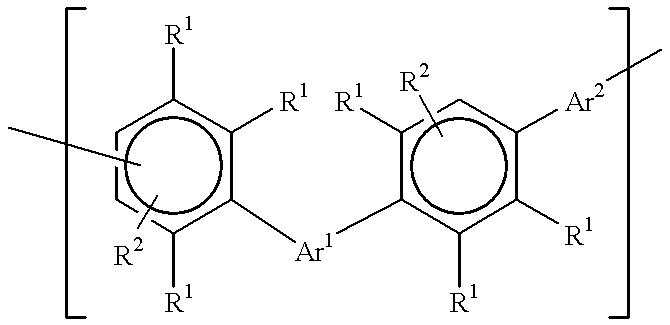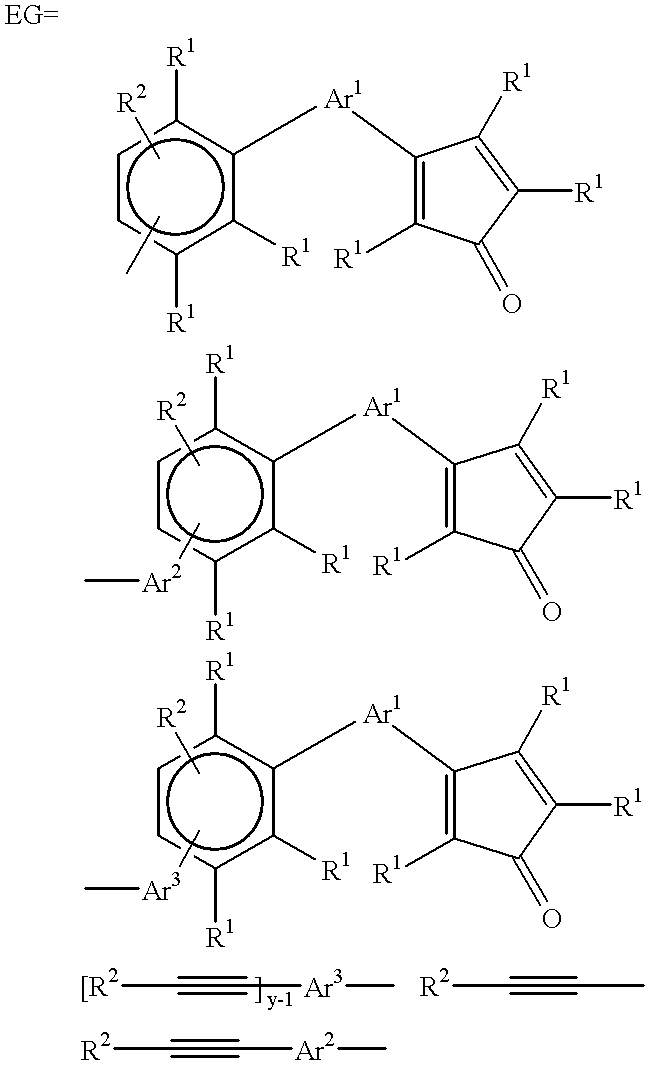Polyphenylene oligomers and polymers
a polyphenylene and polymer technology, applied in the field of polyphenylene oligomers and polymers, can solve the problems of poor planarization and gap filling properties of polyimides, circuit corrosion, and present challenges to process integration during fabrication, and achieve low dielectric constant, high glass transition temperature, and high thermal stability
- Summary
- Abstract
- Description
- Claims
- Application Information
AI Technical Summary
Benefits of technology
Problems solved by technology
Method used
Image
Examples
example 2
Preparation of Polymer from Compound M and a Mixture of 1,3-bis(phenylethynyl)benzene (Compound O) and 1,3,5-tris(phenylethynyl)benzene (Compound G)
Compound (M) (316 mg, FW=762, 0.415 mmol), Compound (O) (72 mg, FW=278, 0.259 mmol) and Compound (G) (44 mg, 0.116 mmol) are refluxed in 1,3-diisopropylbenzene (4 mL) for 42 hours. The dark solution turns red and becomes viscous. The solution is spin-coated on a wafer and cured at 400.degree. C. for 1 hour, forming a film. The reaction scheme is as follows: ##STR19##
example 3
Preparation of Polymer from Compound M and a Mixture of 4,4'-bis(phenylethynyl)-o-terphenyl (Compound I) and 4,4',4"-tris(phenylethynyl)-o-terphenyl (Compound N)
Compound (M) (316 mg, 0.415 mmol), Compound (I) (107 mg, FW=430, 0.249 mmol) and Compound (N) (88 mg, FW=530, 0.166 mmol) are refluxed in 5 mL of 1,3-diisopropylbenzene for 48 hours. The yellow viscous solution is cooled to room temperature and spin-coated on a wafer. The polymer is cured at 400.degree. C. for 1 hour, forming a film. The reaction scheme is as follows: ##STR20## ##STR21##
example 4
Preparation of Polymer from 3,3'-(oxydi-1,4-phenylene)bis(2,4,5-triphenylcyclopentadienone) (Compound K) and 4,4'-Bis(phenylethynyl) Diphenyl Ether (Compound H)
3,3'-(Oxydi-1,4-phenylene)bis(2,4,5-triphenylcyclopentadienone) (15.0000 g, 0.019158 mol), 4,4'-bis(phenylethynyl)diphenyl ether (7.0974 g, 0.019158 mol), and N-methylpyrrolidinone (51.60 g) are added to a 250-mL round bottom flask. The flask is attached to a nitrogen inlet and the magnetically stirred solution is heated to 200.degree. C. in an oil bath. After 19.5 hours at 200.degree. C., gel permeation chromatography indicates a M.sub.n of 1551 and a M.sub.w of 2383 relative to a polystyrene standard. The solution is allowed to cool and is bottled. A portion of the solution is taken up in a syringe and filtered through a 1.0 micron syringe filter onto a 4" silicon wafer. The wafer is spin-coated at 2000 rpm for 60 seconds under a heat lamp which warms the wafer. The coated wafer is then placed on a hot plate set to 90.degre...
PUM
| Property | Measurement | Unit |
|---|---|---|
| melting points | aaaaa | aaaaa |
| thickness | aaaaa | aaaaa |
| thickness | aaaaa | aaaaa |
Abstract
Description
Claims
Application Information
 Login to View More
Login to View More - R&D
- Intellectual Property
- Life Sciences
- Materials
- Tech Scout
- Unparalleled Data Quality
- Higher Quality Content
- 60% Fewer Hallucinations
Browse by: Latest US Patents, China's latest patents, Technical Efficacy Thesaurus, Application Domain, Technology Topic, Popular Technical Reports.
© 2025 PatSnap. All rights reserved.Legal|Privacy policy|Modern Slavery Act Transparency Statement|Sitemap|About US| Contact US: help@patsnap.com



